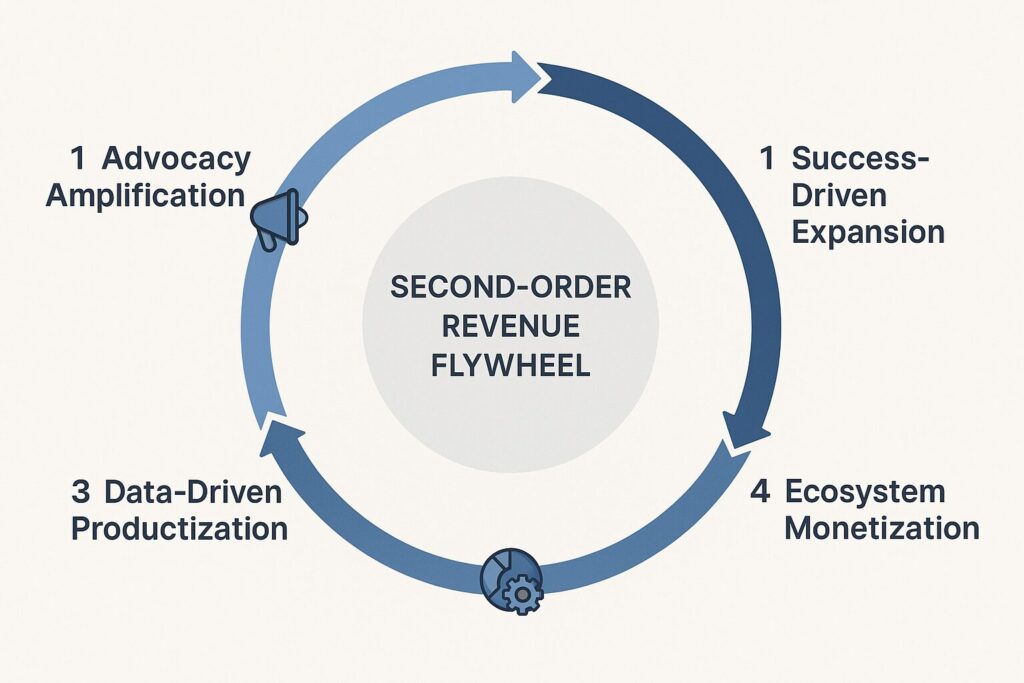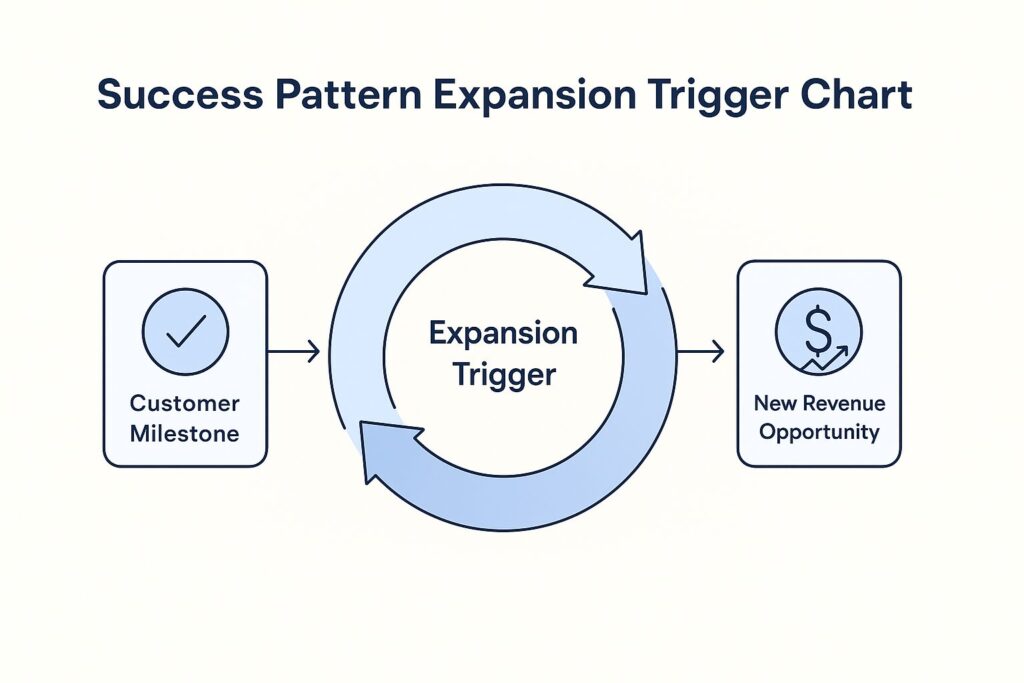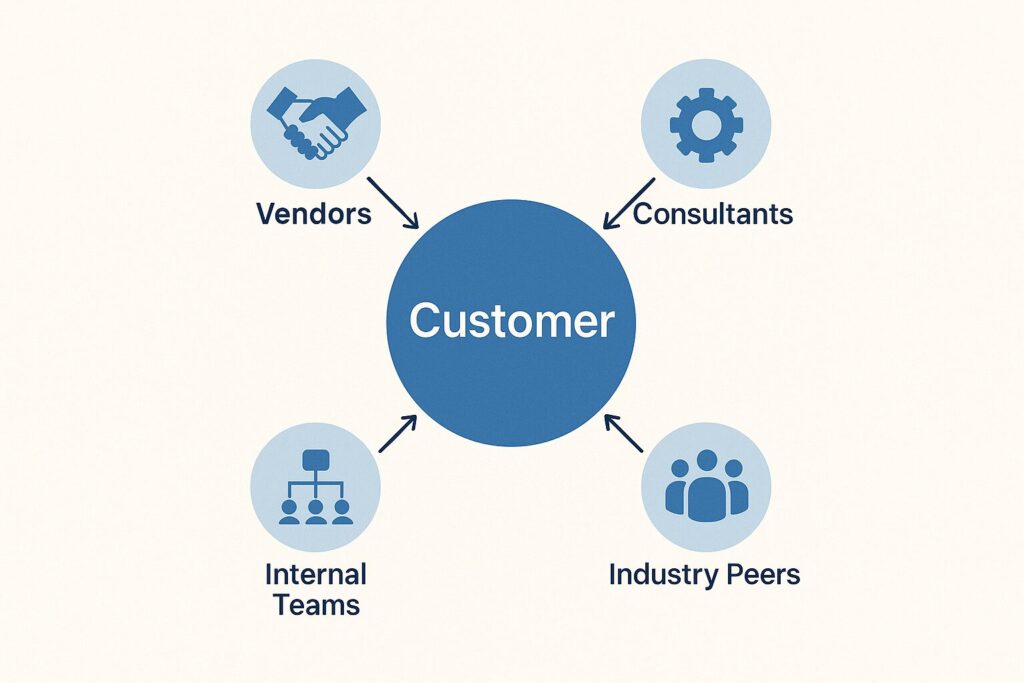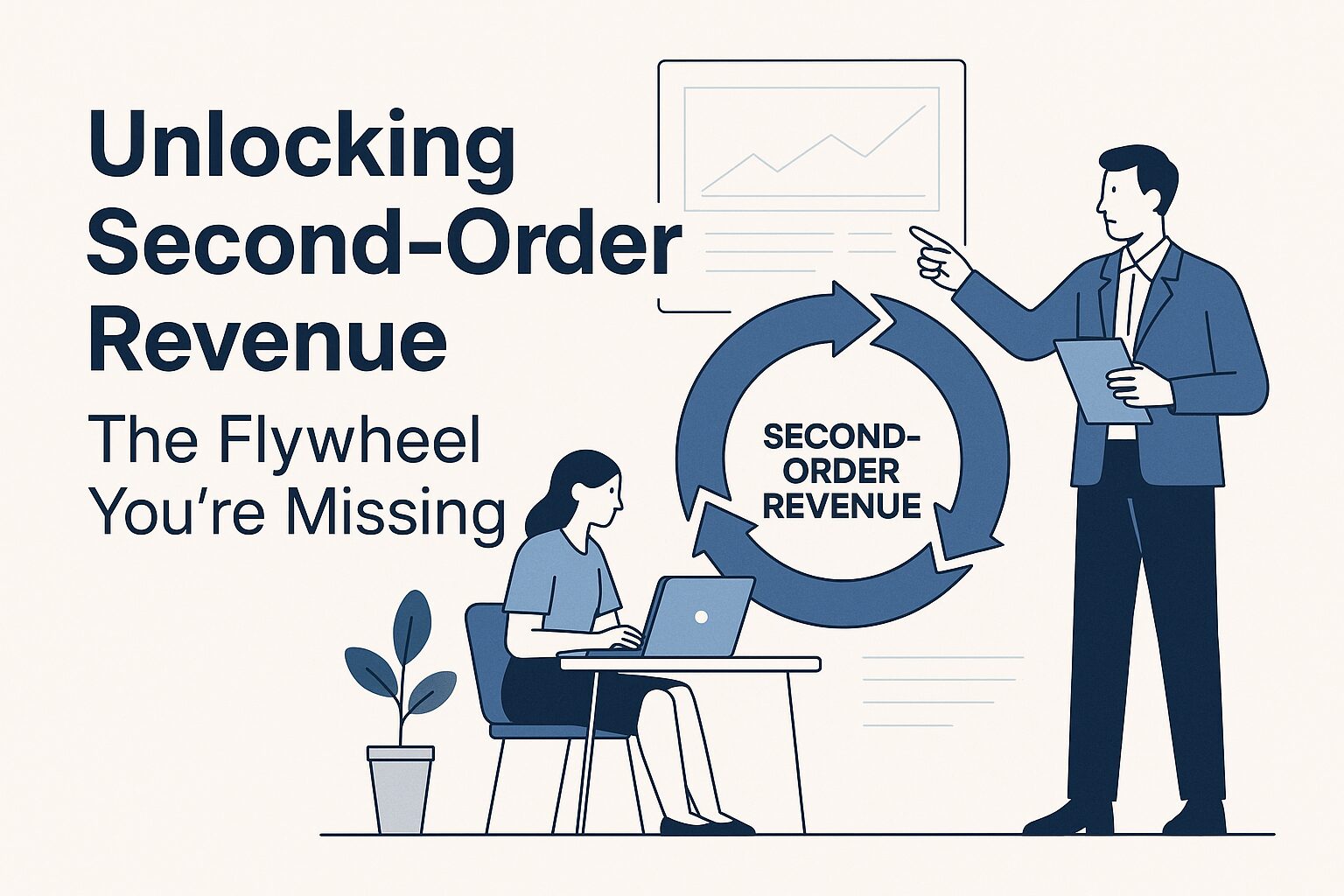Why do some companies seem to effortlessly scale while others hit growth plateaus despite having great products? The growth potential is immense, and it’s within your reach.
Here’s the thing most leaders get wrong: they’re obsessing over first-order revenue (direct sales) while completely ignoring the goldmine sitting right under their noses – second-order revenue. And honestly? It’s not just a missed opportunity; it’s costing them millions.
I learned this the hard way while running operations at a SaaS startup. We were killing ourselves trying to squeeze more juice from our primary revenue streams, working 60-hour weeks and burning through marketing budgets as if there was no tomorrow. Meanwhile, our most profitable customers were quietly generating revenue we weren’t even tracking.
Second-order revenue isn’t just about upsells or cross-sells – it’s about creating self-reinforcing systems where your existing success automatically generates new opportunities. Think of it as the compound interest of business growth.
And as noted in HubSpot’s tech stack guide, shifting from a linear funnel to a flywheel can dramatically boost acquisition and retention by breaking down silos across marketing, sales, and service teams.
What New Leaders Get Wrong About Revenue Generation
Most managers I mentor make the same rookie mistake I did: they think revenue is linear. You invest X in marketing, you acquire Y customers, and you generate Z revenue. Rinse, repeat, scale. But here’s the reality check’s first-order thinking in a second-order world. Understanding this common mistake can be a game-changer in your revenue generation strategy.
But here’s the reality check – that’s first-order thinking in a second-order world. It’s time to shift our mindset and start thinking in terms of second-order revenue.
I recall sitting in a strategy meeting where our CEO was frustrated because our customer acquisition costs continued to rise while our margins remained flat. “We need more leads!” he kept saying. Meanwhile, our customer success team was analyzing data that showed companies implementing our product in a certain way were three times more likely to expand their contracts and refer new business.
The breakthrough came when I realized we weren’t just selling software – we were creating success stories that could sell themselves. But we were treating these success stories like happy accidents instead of engineered outcomes. It’s time to harness the power of these stories for revenue generation.
That’s when I discovered what I now call the Second-Order Revenue Flywheel – a system where every customer success creates measurable, predictable future revenue through multiple channels simultaneously.
As highlighted in Harvard Business Review, companies that build “engine twos”-new growth initiatives adjacent to their core – secure long-term, sustainable revenue streams with lower acquisition risk
The Second-Order Revenue Flywheel: A Framework That Works

After implementing this framework across three different companies, I’ve seen revenue growth rates jump from 20% annually to 150%+ without proportional increases in customer acquisition spend. Here’s how it works:
Component 1: Success-Driven Expansion
Instead of hoping customers will naturally expand, you engineer expansion into the success journey itself. Every milestone your customer hits should unlock a logical next step that requires additional investment.
For example, when customers hit 80% adoption of your core features, that’s not just a success metric – it’s a trigger for your customer success team to introduce advanced features or additional seats. The key is making expansion feel like a natural progression, not a sales pitch.

Component 2: Advocacy Amplification
Happy customers don’t just renew – they become your most effective sales team. However, most companies treat referrals as charity work rather than strategic partnerships.
I implemented a system that directly correlated customer success with advocacy opportunities. Hit certain usage thresholds? You get invited to speak at our user conference. Achieve specific ROI metrics? We feature you in a case study that includes co-marketing opportunities.
According to Bain & Company, companies that lead in Net Promoter Scores grow at more than twice the rate of competitors, underscoring how advocacy can become a powerful, self-sustaining revenue engine (Bain & Company).
Component 3: Data-Driven Productization
Here’s where it gets interesting: your customers’ success patterns become the basis for your following product offerings. Every workflow they create, every integration they build, every process they optimize – that’s market research for your next revenue stream.
One client discovered their customers were using their project management tool to track inventory. Instead of ignoring this “off-label” usage, they productized it into a $2M ARR inventory management add-on within six months.
Component 4: Ecosystem Monetization
Your customers exist in ecosystems – they have vendors, partners, and internal stakeholders who all influence buying decisions. Second-order revenue means monetizing these relationships directly.
Generating second-order revenue could take the form of partnership revenue, referral fees, or new products designed for your customers’ stakeholders. The key is to think beyond just your immediate customer relationship.

Real-World Example: How We 3x’d Revenue Without Tripling Customers
Let me share a specific case study from when I was helping a mid-market B2B company that was stuck at $2M in ARR. They had excellent customer retention but flat growth – classic first-order revenue trap.
Within 18 months of implementing the Second-Order Revenue Flywheel, they hit $6.2M ARR. Here’s exactly what we did:
Months 1-3: Success Pattern Analysis. We analyzed the top 20% of their customers and identified three distinct success patterns. Each pattern had different expansion triggers and advocacy potential.
Months 4-6: Flywheel Design. We built automated workflows that identified when customers hit specific success milestones, triggering expansion conversations, case study opportunities, and referral programs.
Months 7-12: Ecosystem Expansion. We launched a partner program that turned their customers’ vendors into revenue sources, generating $1.2M in additional revenue through referral fees alone.
Months 13-18: Product Evolution Using customer success data, we identified and launched two new product lines that served adjacent needs, adding $4.2M ARR without acquiring a single new customer.
The beauty? Their customer acquisition costs decreased because referrals and word of mouth became their primary growth engine.
Quick Wins: Start Building Your Second-Order Revenue This Week
Ready to stop leaving money on the table? Here are five actions you can take immediately:
1. Audit Your Success Metrics:
List your top 10 customer success indicators. For each one, identify what logical next step or expansion opportunity it could trigger. Most companies have 3-5 obvious expansion triggers they’re completely ignoring.
2. Map Your Customer Ecosystem.
For your top 20% of customers, document who else influences their buying decisions. These stakeholders include your customers’ vendors, consultants, industry peers, and even their internal teams. Each relationship is a potential revenue channel.
3. Create Success-Based Triggers:
Build simple automated workflows that alert your team when customers hit specific success milestones. These become your opportunities for expansion and advocacy.
4. Productize Your Patterns.
Observe how your most successful customers utilize your product in different ways. These “creative” use cases often represent your following product line or premium feature set.
5. Design Advocacy Incentives:
Develop formal programs that reward customer success with opportunities for advocacy. Speaking slots, case studies, and co-marketing – make advocacy feel like a privilege, not a favor.
The Strategic Advantage of Second-Order Thinking
Here’s what separates truly scalable companies from those that hit growth plateaus: they understand that sustainable growth comes from creating systems where success breeds more success.
First-order revenue is about extraction – how much can you get from each customer interaction? Second-order revenue is about multiplication – how can each customer’s success create multiple new revenue opportunities?
The goal isn’t merely to become more efficient with your existing customers (though that’s a valuable side benefit); it’s also to attract new ones. It’s about fundamentally changing how you think about business growth. Instead of always needing new inputs to create new outputs, you’re creating compounding systems where outputs become inputs for future growth.
The companies that master this flywheel don’t just grow faster – they produce more predictably, more profitably, and more sustainably than their competitors.
Ready to stop chasing new customers and start maximizing the goldmine you already have? The Second-Order Revenue Flywheel isn’t just a growth strategy – it’s a competitive advantage that gets stronger over time.
What’s your most enormous second-order revenue opportunity that you’re currently missing? Please drop a comment below, and let’s discuss how to turn your customer success into your next growth engine.
If you’re ready to dive even deeper into second-order revenue strategy and make this framework work for your business, here are some frequently asked questions to help clarify and guide your next steps.
What is second-order revenue?
Second-order revenue refers to growth that doesn’t come directly from new customer acquisition but instead arises through expansion, advocacy, and ecosystem monetization from your existing customer base. Think of it as the compounding interest of your revenue strategy.
How is a flywheel different from a traditional sales funnel?
A traditional funnel focuses on pushing leads through a linear path to conversion. In contrast, a flywheel is a self-reinforcing system where customer success fuels momentum, generating ongoing referrals, upsells, and expansion, creating continuous, compounding growth.
Can small and mid-size businesses use a second-order revenue strategy?
Yes. While large SaaS and enterprise companies often lead the way, small and mid-sized businesses can also implement these strategies by focusing on customer success, loyalty incentives, and community partnerships to generate additional revenue without incurring heavy acquisition costs.
What are examples of customer milestones that can trigger expansion?
Examples include reaching a certain usage threshold, adopting specific product features, achieving ROI targets, or completing training milestones. Each milestone should serve as a logical point to introduce new services, add-ons, or premium upgrades.
What tools can help implement a second-order revenue flywheel?
Standard tools include CRM and customer success platforms (like HubSpot, Salesforce, or Gainsight), automated marketing and advocacy tools, usage analytics dashboards, and partner ecosystem management software. The key is integrating data and success signals to trigger effective expansion and advocacy workflows.
Follow me on LinkedIn for daily posts on AI, operations, and growth strategy that you won’t find anywhere else.
Related Articles
Guide Part 1 – The Ultimate B2C Growth Metrics Guide to Explode Your Revenue
Guide Part 2 – B2C Brand Health Metrics Guide: Unlock Growth Now
How to Create a Winning Data-Driven Sales Strategy
Proven B2B Outreach Strategy That Gets Real Results
B2B Metric Frameworks Infographics: Unlock Growth & Profits Now
About the Author
I write about:
- AI + MarTech Automation
- AI Strategy
- COO Ops & Systems
- Growth Strategy (B2B & B2C)
- Infographic
- Leadership & Team Building
- My Case Studies
- Personal Journey
- Revenue Operations (RevOps)
- Sales Strategy
- SEO & Digital Marketing
- Strategic Thinking
📩 Want 1:1 strategic support?
🔗 Connect with me on LinkedIn
📬 Read my playbooks on Substack

Leave a Reply